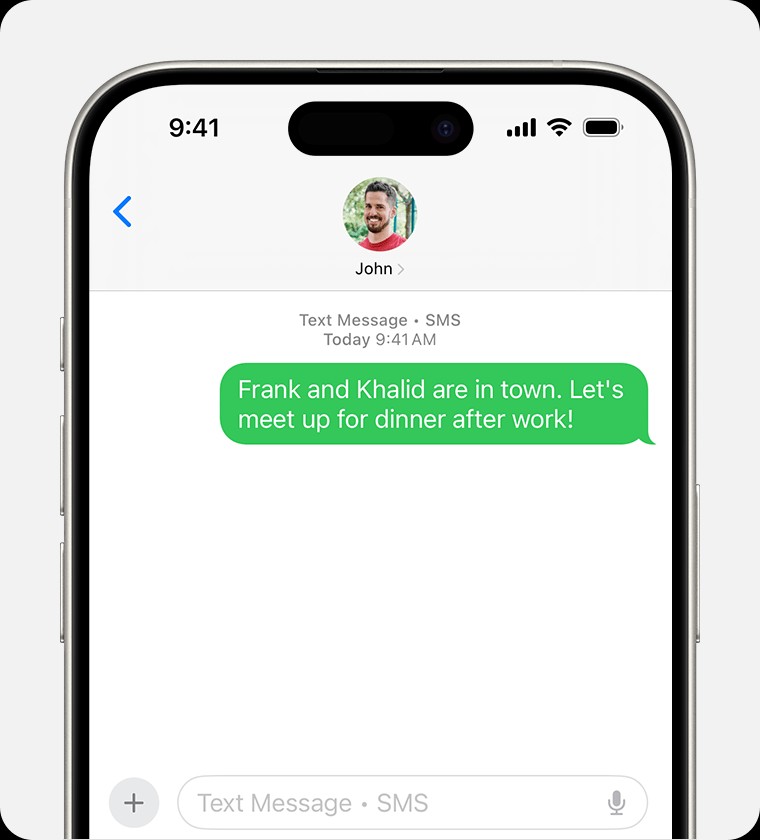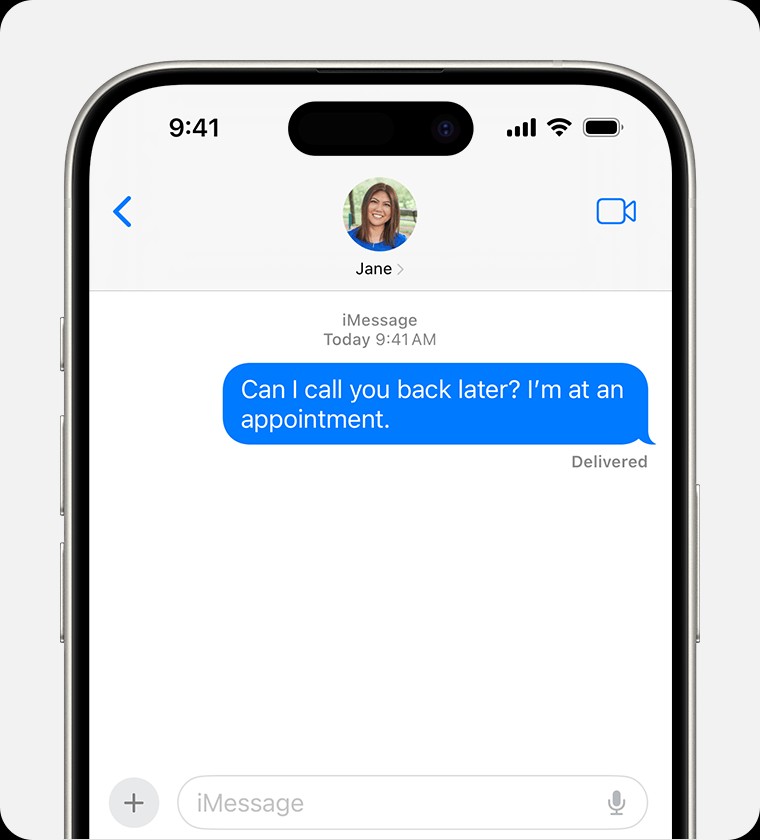Why Does It Say Rcs In My Text Messages? This question has become increasingly common as mobile technology evolves, and WHY.EDU.VN is here to provide a comprehensive answer. Unraveling the complexities of modern messaging protocols like RCS requires understanding its benefits, limitations, and how it interacts with other messaging standards such as SMS and iMessage. Let’s dive into the world of RCS messaging, advanced messaging, and enhanced communication, ensuring you’re well-informed about this technological advancement.
1. Understanding Rich Communication Services (RCS)
RCS, or Rich Communication Services, is the next-generation SMS protocol designed to replace the older SMS and MMS standards. It brings many of the features you find in modern messaging apps like iMessage and WhatsApp to standard text messaging. RCS aims to enhance your messaging experience with features like read receipts, typing indicators, high-resolution media sharing, and group chats.
1.1 The Evolution from SMS to RCS
SMS (Short Message Service) was revolutionary when it first appeared, allowing brief text messages to be sent between mobile phones. MMS (Multimedia Messaging Service) followed, adding support for images, audio, and video. However, both technologies are quite old and have limitations compared to modern messaging apps. RCS is intended to overcome these limitations, offering a richer, more interactive messaging experience.
1.2 Key Features of RCS Messaging
RCS brings a host of new features to text messaging, including:
- High-Resolution Media Sharing: Share high-quality photos and videos without the compression issues common in SMS/MMS.
- Read Receipts and Typing Indicators: Know when your message has been read and when the other person is typing a response.
- Group Chats: Enhanced group messaging with support for larger groups and richer features.
- Enhanced Security: While not end-to-end encrypted in all implementations, RCS offers better security than SMS/MMS.
- Business Messaging: Brands can use RCS to send richer, more interactive messages to customers, including branding, suggested replies, and carousels.
1.3 How RCS Works
RCS works over the internet, using either Wi-Fi or cellular data. When you send an RCS message, it is routed through your mobile carrier’s RCS infrastructure. If the recipient also supports RCS, they will receive the message with all its rich features. If the recipient does not support RCS, the message may fall back to SMS/MMS.
2. Why You See RCS in Your Text Messages
Seeing RCS in your text messages indicates that your phone and carrier support the RCS protocol, and you are communicating with someone else who also has RCS enabled. This means you are enjoying the enhanced features that RCS offers over traditional SMS/MMS.
2.1 Carrier Support for RCS
The rollout of RCS has been gradual, with carriers around the world adopting the standard at different rates. To use RCS, your carrier must support it. In many countries, major carriers have already enabled RCS for their subscribers.
2.2 Device Compatibility
In addition to carrier support, your device must also be compatible with RCS. Most modern Android smartphones support RCS, often through the Google Messages app. Apple has also started to support RCS on iPhones with the release of iOS 18.
2.3 Enabling RCS on Your Device
To enable RCS on your device, you typically need to use a messaging app that supports it, such as Google Messages. In Google Messages, you can usually find the RCS settings under “Chat features” in the app’s settings menu. Once enabled, the app will attempt to verify your phone number and activate RCS.
3. RCS vs. SMS/MMS: A Detailed Comparison
To fully appreciate the benefits of RCS, it’s helpful to compare it directly with SMS and MMS. Here’s a detailed breakdown:
3.1 Features and Functionality
| Feature | SMS/MMS | RCS |
|---|---|---|
| Text Messaging | Basic text messages | Rich text messages with enhanced formatting |
| Media Sharing | Low-resolution photos and videos | High-resolution photos and videos |
| Read Receipts | Not supported | Supported |
| Typing Indicators | Not supported | Supported |
| Group Chats | Limited functionality | Enhanced group chats with more features |
| File Transfer | Limited or not supported | Supports larger files |
| Security | Basic | Improved, but not always end-to-end encrypted |
| Business Messaging | Limited | Rich, interactive business messaging |
| Data Usage | Uses cellular data | Uses Wi-Fi or cellular data |
| Global Standard | Yes | Gradually being adopted |


3.2 Advantages of RCS Over SMS/MMS
- Enhanced User Experience: RCS offers a much richer and more interactive messaging experience compared to SMS/MMS.
- Better Media Quality: Sharing high-resolution photos and videos is a significant improvement.
- Improved Communication: Read receipts and typing indicators make conversations feel more real-time.
- Business Opportunities: RCS opens up new possibilities for businesses to engage with customers.
3.3 Disadvantages of RCS Compared to SMS/MMS
- Availability: RCS is not yet universally supported by all carriers and devices.
- Security Concerns: While improved, RCS is not always end-to-end encrypted.
- Complexity: Setting up and troubleshooting RCS can be more complex than SMS/MMS.
4. RCS vs. iMessage: Understanding the Differences
While RCS aims to bring modern messaging features to Android and other platforms, Apple’s iMessage has offered similar capabilities for years. Here’s a comparison between RCS and iMessage:
4.1 Features and Functionality
| Feature | iMessage | RCS |
|---|---|---|
| Text Messaging | Rich text messages with formatting | Rich text messages with enhanced formatting |
| Media Sharing | High-resolution photos and videos | High-resolution photos and videos |
| Read Receipts | Supported | Supported |
| Typing Indicators | Supported | Supported |
| Group Chats | Enhanced group chats | Enhanced group chats with more features |
| File Transfer | Supports larger files | Supports larger files |
| Security | End-to-end encryption | Improved, but not always end-to-end encrypted |
| Business Messaging | Limited | Rich, interactive business messaging |
| Data Usage | Uses Wi-Fi or cellular data | Uses Wi-Fi or cellular data |
| Platform | Apple devices only | Android and other platforms |
4.2 Advantages of iMessage Over RCS
- End-to-End Encryption: iMessage offers end-to-end encryption, providing a higher level of security.
- Seamless Integration: iMessage is deeply integrated into the Apple ecosystem, offering a seamless experience across all Apple devices.
4.3 Advantages of RCS Over iMessage
- Cross-Platform Compatibility: RCS works on Android and other platforms, making it more versatile.
- Carrier Support: RCS is supported by many carriers, making it a more universal solution.
5. The Future of RCS Messaging
The future of RCS messaging looks promising as more carriers and devices adopt the standard. RCS has the potential to become the universal standard for text messaging, replacing SMS/MMS and offering a richer, more interactive experience for users worldwide.
5.1 Universal Adoption
For RCS to truly succeed, universal adoption is key. This means that all major carriers and device manufacturers need to support the standard. While progress has been made, there is still work to be done to achieve full adoption.
5.2 Enhanced Security
One of the key areas for improvement is security. Implementing end-to-end encryption in all RCS implementations would make it a more secure messaging platform.
5.3 New Features and Capabilities
As RCS evolves, we can expect to see new features and capabilities added to the standard. This could include better support for interactive content, enhanced business messaging, and improved integration with other apps and services.
6. Troubleshooting Common RCS Issues
While RCS offers many benefits, it can also be prone to issues. Here are some common problems and how to troubleshoot them:
6.1 RCS Not Activating
If RCS is not activating on your device, try the following steps:
- Check Carrier Support: Make sure your carrier supports RCS.
- Update Messaging App: Ensure you have the latest version of your messaging app.
- Verify Phone Number: Double-check that your phone number is correctly entered in the app settings.
- Clear App Cache: Clear the cache and data of your messaging app.
- Restart Device: Restart your device to refresh the connection.
6.2 Messages Not Sending as RCS
If your messages are not sending as RCS, it could be due to the following reasons:
- Recipient Not on RCS: The recipient may not have RCS enabled or supported on their device.
- Connectivity Issues: Check your Wi-Fi or cellular data connection.
- App Settings: Verify that RCS is enabled in your messaging app settings.
- Carrier Issues: There may be a temporary issue with your carrier’s RCS infrastructure.
6.3 Battery Drain
RCS can sometimes cause increased battery drain. To mitigate this:
- Optimize App Settings: Adjust the app settings to reduce background activity.
- Limit Data Usage: Use Wi-Fi when possible to reduce cellular data usage.
- Update App: Ensure you have the latest version of the app, as updates often include battery optimizations.
7. Business Applications of RCS Messaging
RCS offers significant opportunities for businesses to engage with customers in new and innovative ways. Here are some key applications:
7.1 Rich Marketing Messages
Businesses can send richer, more engaging marketing messages with branding, images, videos, and interactive elements.
7.2 Customer Support
RCS can be used to provide enhanced customer support with suggested replies, quick actions, and rich media.
7.3 Appointment Reminders
Send appointment reminders with interactive buttons to confirm, reschedule, or cancel appointments.
7.4 Order Updates
Provide real-time order updates with tracking information, delivery notifications, and customer support options.
8. Privacy and Security Considerations with RCS
While RCS offers advancements in features, it’s crucial to address the privacy and security aspects.
8.1 Encryption Standards
RCS does not always employ end-to-end encryption, which means messages might be vulnerable during transit. Unlike iMessage or Signal, the lack of consistent encryption is a concern for privacy-focused users.
8.2 Data Collection
RCS relies on carriers and third-party providers, which collect data like IP addresses and phone numbers. Understanding the data handling policies of your carrier is essential for maintaining privacy.
8.3 Security Best Practices
To enhance security:
- Use a VPN: Protect your IP address.
- Review Carrier Policies: Understand how your carrier handles RCS data.
- Stay Informed: Keep up-to-date with security updates and potential vulnerabilities.
9. How to Check if Your Carrier Supports RCS
Determining if your carrier supports RCS involves a few steps:
9.1 Checking Carrier Websites
Visit your carrier’s official website and search for information on RCS support. Many carriers have detailed FAQs or support pages covering RCS.
9.2 Contacting Customer Support
Call your carrier’s customer support line and ask directly about RCS support. They can provide specifics on availability and how to enable it.
9.3 Using Messaging App Settings
Most messaging apps that support RCS have a settings section where you can check the status of RCS. For example, Google Messages has a “Chat features” section.
10. Common Misconceptions About RCS
There are several misconceptions about RCS that need clarification:
10.1 RCS is Always Encrypted
Contrary to belief, RCS is not always end-to-end encrypted. The level of encryption depends on the implementation by the carrier and the messaging app.
10.2 RCS Requires a New Phone
RCS does not necessarily require a new phone. Most modern Android smartphones can support RCS with a software update and carrier support.
10.3 RCS is the Same as iMessage
While RCS and iMessage share similar features, they are different protocols. iMessage is exclusive to Apple devices and offers end-to-end encryption, whereas RCS is designed to be cross-platform but lacks consistent encryption.
11. Step-by-Step Guide to Enabling RCS on Android
Enabling RCS on an Android device is straightforward:
- Open Google Messages: Ensure you have the Google Messages app installed.
- Go to Settings: Tap the three dots in the upper right corner and select “Settings.”
- Chat Features: Select “Chat features” to find RCS settings.
- Enable RCS: Toggle the switch to enable RCS.
- Verify Number: The app will verify your phone number to activate RCS.
12. How RCS Enhances Group Messaging
RCS significantly enhances group messaging with features like:
12.1 Larger Group Sizes
RCS supports larger group sizes compared to traditional SMS/MMS.
12.2 High-Quality Media Sharing
Share high-resolution photos and videos within the group without compression.
12.3 Read Receipts and Typing Indicators
See who has read your messages and who is currently typing.
12.4 Rich Media and Interactive Elements
Incorporate rich media and interactive elements for a more engaging group experience.
13. RCS and the Impact on Mobile Marketing
RCS presents new opportunities for mobile marketing:
13.1 Branded Messages
Businesses can send branded messages with their logo and color scheme.
13.2 Interactive Content
Use interactive buttons, carousels, and rich media to engage customers.
13.3 Enhanced Customer Engagement
Provide real-time support, appointment reminders, and order updates directly through RCS.
13.4 Improved Conversion Rates
Leverage RCS to improve conversion rates with personalized and interactive marketing messages.
14. Comparing Data Usage: RCS vs. SMS/MMS
Understanding the data usage of RCS compared to SMS/MMS is essential for managing your mobile plan:
14.1 SMS/MMS Data Usage
SMS uses minimal data as it transmits plain text. MMS, which includes media, uses more data but still relatively low.
14.2 RCS Data Usage
RCS uses more data than SMS/MMS, especially when sending high-resolution media. It relies on Wi-Fi when available, which can help reduce cellular data usage.
14.3 Tips to Manage Data Usage with RCS
- Use Wi-Fi: Connect to Wi-Fi whenever possible.
- Optimize Media Settings: Adjust media settings to reduce the size of photos and videos.
- Monitor Data Usage: Keep track of your data usage to avoid overage charges.
15. Apple’s Adoption of RCS: What It Means for Users
Apple’s decision to adopt RCS is a significant development:
15.1 Enhanced Interoperability
RCS support on iPhones will improve messaging interoperability between iOS and Android devices.
15.2 Better Messaging Experience
iPhone users will enjoy a richer messaging experience when communicating with Android users.
15.3 Broader Adoption of RCS
Apple’s support will likely accelerate the broader adoption of RCS across the industry.
15.4 Competition with iMessage
RCS may pose some competition to iMessage, though iMessage’s end-to-end encryption remains a key differentiator.
16. Potential Downsides of Using RCS
Despite its benefits, RCS has potential downsides:
16.1 Lack of End-to-End Encryption
As mentioned, RCS does not always offer end-to-end encryption.
16.2 Reliance on Carrier Support
RCS depends on carrier support, which can vary by region and provider.
16.3 Compatibility Issues
Compatibility issues can arise if the recipient does not support RCS.
16.4 Data Privacy Concerns
Data privacy concerns exist due to the collection of data by carriers and third-party providers.
17. Real-World Examples of RCS Use Cases
RCS is being used in various real-world scenarios:
17.1 Retail
Retailers send rich marketing messages, product updates, and customer support via RCS.
17.2 Banking
Banks use RCS for fraud alerts, transaction confirmations, and customer service.
17.3 Healthcare
Healthcare providers send appointment reminders, prescription updates, and health tips through RCS.
17.4 Travel
Travel companies provide flight updates, booking confirmations, and travel recommendations via RCS.
18. How RCS is Changing Business Communication
RCS is transforming business communication:
18.1 Enhanced Customer Experience
Businesses provide a more engaging and interactive customer experience.
18.2 Improved Communication Efficiency
Real-time updates and interactive features improve communication efficiency.
18.3 Better Customer Engagement
Personalized and branded messages enhance customer engagement.
18.4 Increased Sales and Conversions
RCS helps drive sales and conversions with targeted marketing messages.
19. Tips for Optimizing RCS for Business Use
To optimize RCS for business use:
19.1 Personalize Messages
Personalize messages with customer data for better engagement.
19.2 Use Rich Media
Incorporate high-quality images, videos, and interactive elements.
19.3 Provide Value
Offer valuable information, updates, and customer support.
19.4 Track Performance
Track the performance of RCS campaigns to optimize results.
20. The Role of Google in RCS Development
Google has played a significant role in the development and promotion of RCS:
20.1 Driving RCS Adoption
Google has actively promoted RCS adoption by carriers and device manufacturers.
20.2 Developing the Google Messages App
Google’s Messages app is a key platform for enabling RCS on Android devices.
20.3 Supporting RCS Standards
Google supports and contributes to RCS standards development.
20.4 Partnering with Carriers
Google partners with carriers to deploy RCS globally.
21. Future Predictions for RCS Technology
Future predictions for RCS technology include:
21.1 Widespread Adoption
Widespread adoption of RCS across all major carriers and devices.
21.2 Enhanced Security
Implementation of end-to-end encryption for all RCS messages.
21.3 Integration with Other Platforms
Integration of RCS with other messaging and communication platforms.
21.4 New Features and Capabilities
Development of new features and capabilities for RCS, such as interactive content and AI-driven communication.
22. How to Switch Back to SMS/MMS from RCS
If you encounter issues with RCS or prefer to use SMS/MMS, you can switch back:
- Open Google Messages: Open the Google Messages app.
- Go to Settings: Tap the three dots in the upper right corner and select “Settings.”
- Chat Features: Select “Chat features.”
- Disable RCS: Toggle the switch to disable RCS.
23. Key Terms and Definitions Related to RCS
Understanding key terms related to RCS is essential:
23.1 RCS (Rich Communication Services)
The next-generation SMS protocol designed to replace SMS/MMS.
23.2 SMS (Short Message Service)
The traditional text messaging standard.
23.3 MMS (Multimedia Messaging Service)
A standard for sending messages that include multimedia content.
23.4 End-to-End Encryption
A security method where only the sender and receiver can read the messages.
23.5 Carrier
A mobile network operator that provides wireless services.
24. Comparing RCS to Other Messaging Apps Like WhatsApp and Telegram
Comparing RCS to other messaging apps helps understand its unique position:
24.1 WhatsApp
WhatsApp offers end-to-end encryption and is widely used globally.
24.2 Telegram
Telegram provides end-to-end encryption and focuses on privacy.
24.3 RCS
RCS aims to replace SMS/MMS and offers rich features but lacks consistent end-to-end encryption.
24.4 Key Differences
The key differences lie in encryption, platform support, and reliance on carrier support.
25. The Impact of 5G on RCS Performance
5G technology enhances RCS performance:
25.1 Faster Data Speeds
5G provides faster data speeds, improving the speed and reliability of RCS messaging.
25.2 Lower Latency
Lower latency reduces delays in message delivery.
25.3 Enhanced Media Quality
5G enables the sharing of higher-quality media through RCS.
25.4 Improved Reliability
5G improves the reliability of RCS messaging, especially in crowded areas.
26. Addressing Privacy Concerns with RCS
Addressing privacy concerns is crucial for RCS adoption:
26.1 Transparency
Providing transparency about data collection practices.
26.2 User Control
Giving users control over their data and privacy settings.
26.3 Encryption
Implementing end-to-end encryption for all RCS messages.
26.4 Compliance
Complying with privacy regulations and standards.
27. How to Stay Updated on RCS Developments
To stay updated on RCS developments:
27.1 Follow Tech Blogs
Follow tech blogs and news sites for the latest updates.
27.2 Subscribe to Newsletters
Subscribe to newsletters from industry experts and organizations.
27.3 Attend Industry Events
Attend industry events and conferences.
27.4 Join Online Communities
Join online communities and forums.
28. RCS for Emergency Alerts and Public Safety
RCS can be used for emergency alerts and public safety:
28.1 Rich Emergency Alerts
Sending rich emergency alerts with maps, images, and interactive elements.
28.2 Real-Time Updates
Providing real-time updates on emergency situations.
28.3 Targeted Messaging
Sending targeted messages to specific geographic areas.
28.4 Improved Communication
Improving communication between emergency responders and the public.
29. The Future of Messaging: Where Does RCS Fit In?
The future of messaging is evolving:
29.1 RCS as a Universal Standard
RCS has the potential to become a universal standard for messaging.
29.2 Integration with AI
Integration of AI for enhanced messaging experiences.
29.3 Focus on Privacy
Increased focus on privacy and security.
29.4 Enhanced Interoperability
Enhanced interoperability between messaging platforms.
30. Frequently Asked Questions (FAQs) About RCS
Here are some frequently asked questions about RCS:
30.1 What is RCS?
RCS (Rich Communication Services) is the next-generation SMS protocol.
30.2 Is RCS Secure?
RCS is more secure than SMS/MMS, but it does not always offer end-to-end encryption.
30.3 How Do I Enable RCS?
You can enable RCS in the settings of your messaging app, such as Google Messages.
30.4 Is RCS Free?
RCS uses Wi-Fi or cellular data, so it may incur data charges.
30.5 What are the Benefits of RCS?
The benefits of RCS include richer messaging features, high-quality media sharing, and improved communication.
30.6 Does Apple Support RCS?
Yes, Apple supports RCS on iPhones with the release of iOS 18.
30.7 How Does RCS Compare to iMessage?
RCS is cross-platform, while iMessage is exclusive to Apple devices. iMessage offers end-to-end encryption.
30.8 What is the Future of RCS?
The future of RCS includes widespread adoption, enhanced security, and integration with other platforms.
30.9 Can Businesses Use RCS?
Yes, businesses can use RCS for marketing, customer support, and communication.
30.10 How Does 5G Affect RCS?
5G improves the speed, reliability, and quality of RCS messaging.
Understanding why it says RCS in your text messages involves grasping the evolution of messaging technology, the features of RCS, and its comparison with other messaging platforms. As RCS continues to evolve, it promises to offer a richer and more interactive messaging experience for users worldwide. At WHY.EDU.VN, we strive to provide clear, comprehensive answers to your questions, ensuring you stay informed in this rapidly changing technological landscape.
Do you have more questions about RCS or other technology-related topics? Visit WHY.EDU.VN at 101 Curiosity Lane, Answer Town, CA 90210, United States, or contact us via WhatsApp at +1 (213) 555-0101. Our experts are here to provide the answers you need. Navigate the complexities of the digital world with ease and confidence, thanks to the expertise available at why.edu.vn. Let us help you explore, understand, and thrive in today’s tech-driven environment, providing insights into data privacy, enhanced communication, and more!

